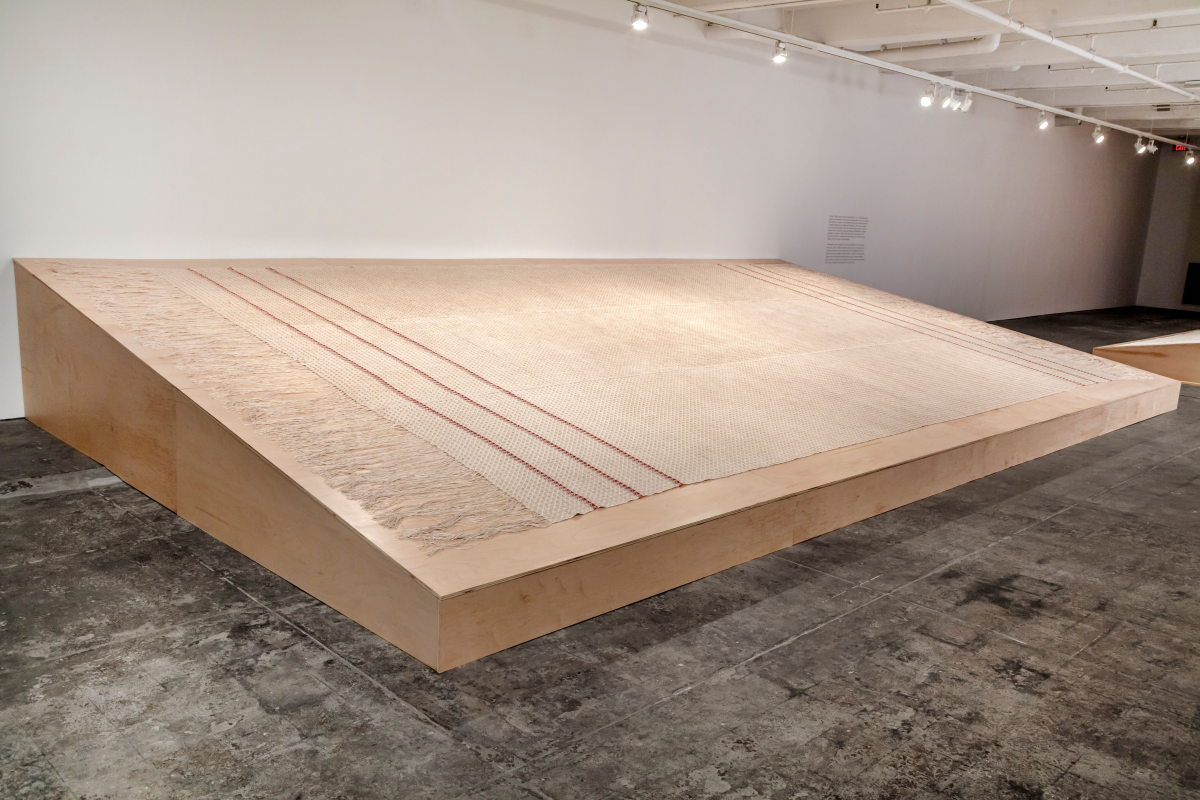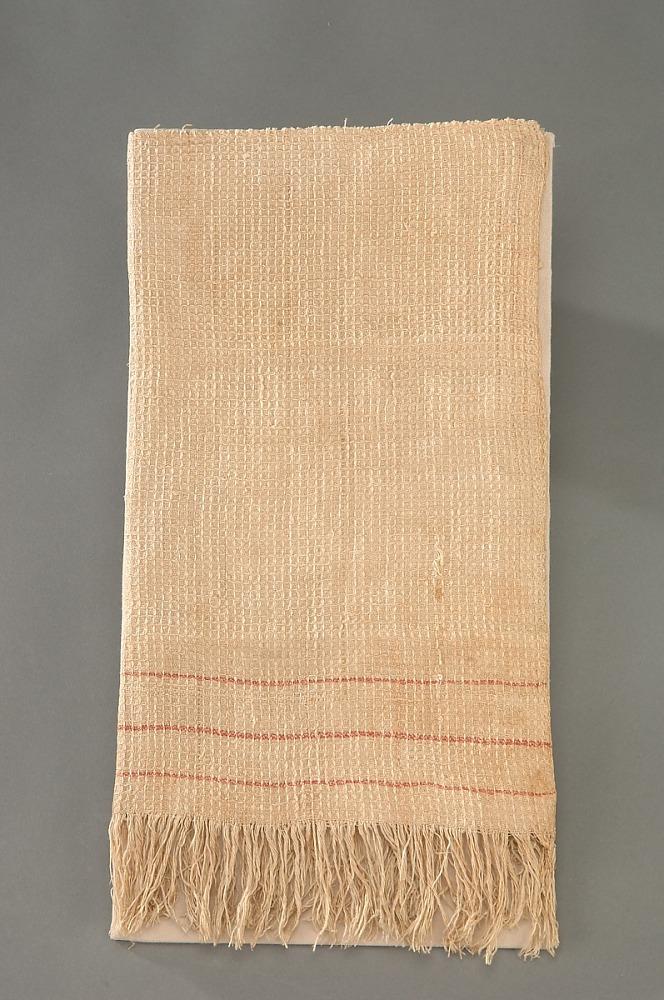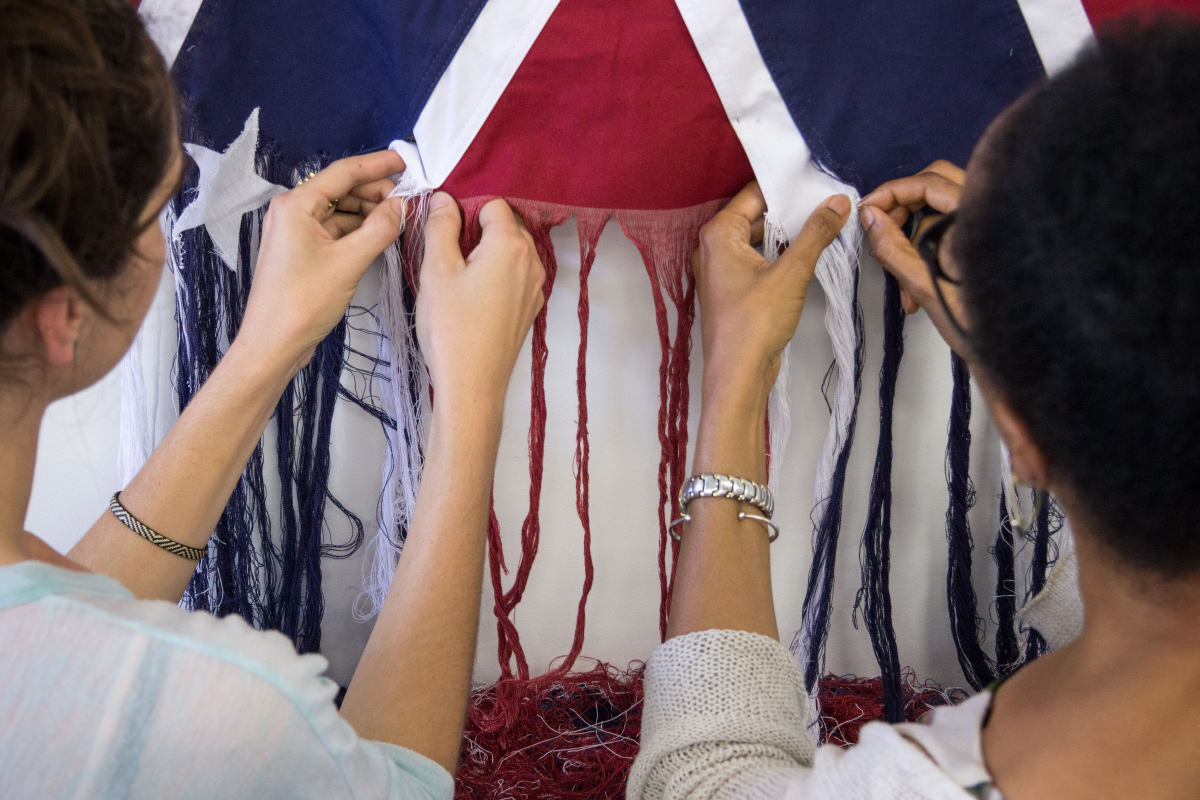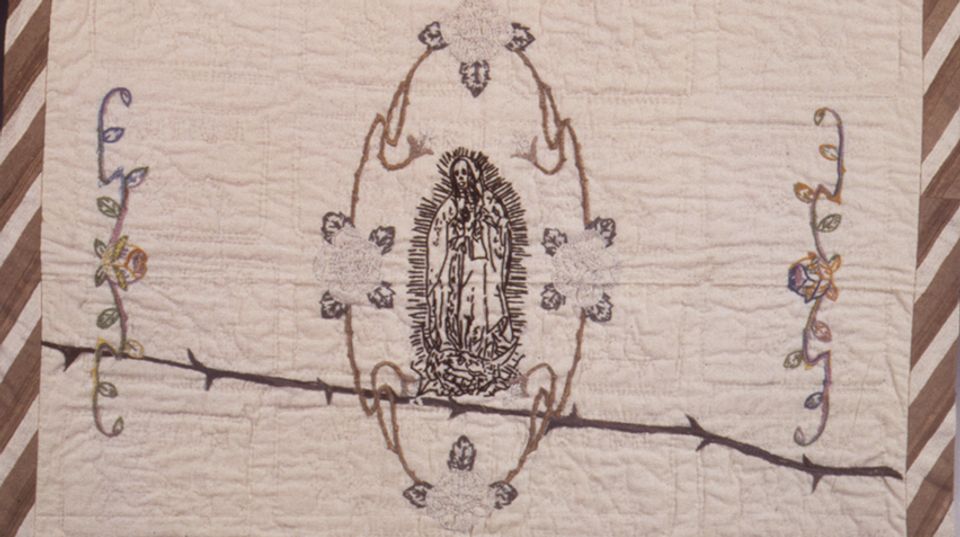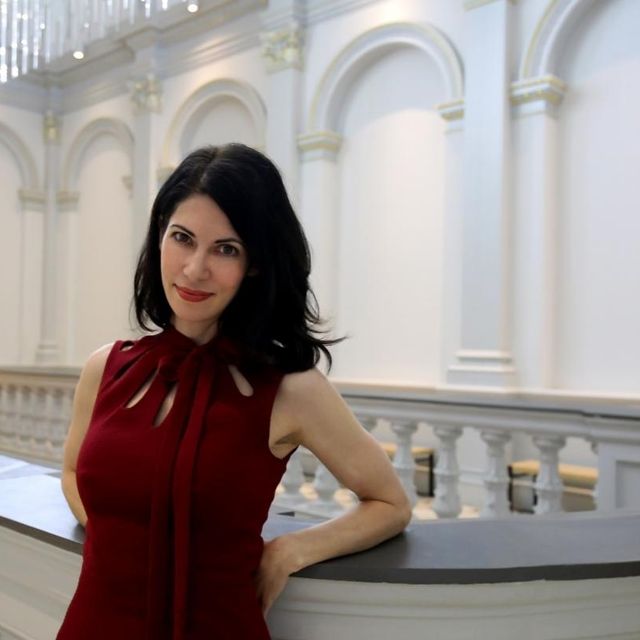
Sonya Clark is undoubtedly among the most celebrated contemporary craft artists working in the United States today.
Working in the medium of fiber—in its very broadest sense—Sonya Clark weaves stories not only in fabric and thread, but an array of materials including hair, combs, buttons, flags, and even currency. Of these, she is best known for investigating two recurring themes—hair and flags—through which she reflects on notions of personal and collective identity, celebrating Blackness while interrogating historical imbalances and the roots of racial injustice. In her hair works, she embeds a tenderness surrounding her own memories of girlhood braids, and pays homage to the empowerment and artistry of Black hair traditions; in her flag pieces she conveys a profound sense of the dissonance between American ideals and the realities of what it means to be Black in America today. Often incorporating performance and participation, Clark’s works directly and powerfully engage audiences in complex meditations around race, culture, gender, and class in America in ways that promote true dialogue on these charged subjects.
I first got to know Clark around 2010, through her powerful portraits of Madam C.J. Walker, which she made by carefully assembling pocket combs, removing certain tines to bring forth an image. For those unfamiliar, Walker was one of the first American women to become a self-made millionaire, and she did so by selling products designed to “tame” Black hair—so it both celebrates this formidable woman, while at the same time questioning whether such hair needs to be tamed. Since then, Clark’s work has been included in more than 300 museum and gallery exhibitions, including a recent solo show at the National Museum of Women in the Arts and a traveling exhibition, Monumental Cloth: The Flag We Should Know, organized by The Fiber Workshop in Philadelphia. Clark collaborated with The Fiber Workshop to create Monumental, inspired by two objects in the collection of the Smithsonian’s National Museum of American History.
In 2011, Clark was awarded a Smithsonian Artist Residence Fellowship (SARF), which afforded her time to do research for her artwork in DC, digging into Smithsonian collections. While exploring the galleries at the National Museum of American History, Clark came upon an unassuming dishtowel, which she discovered was the white cloth waved at Appomattox Court House in 1865 to signal the Confederate army’s surrender. It immediately sparked in her a curiosity about why she was not familiar with this important object, when the Confederate battle flag is so emblazoned in all of our minds. In response, she began to formulate a question, “What if this flag of truce was the flag we knew, instead of the Confederate battle flag?”
Following this line of thought, she set out to recreate and recontextualize the truce flag in Monumental Cloth: The Flag We Should Know. Monumental, the centerpiece of that body of work, recently acquired by SAAM, is a woven replica of the truce flag enlarged to the monumental scale of fifteen feet by thirty feet, drawing allusion to another object in the National Museum of American History’s collection, the Star-Spangled Banner.
The subject matter behind Monumental, and this larger series is an outgrowth of earlier projects. In another related ‘flag’ work, Unraveling, for which Clark gained notoriety, she and a group of participants work together in a gallery performance, laboriously unweaving a commercially-produced Confederate battle flag while talking about their experiences. But while this project continues today, Clark noticed an interesting side-effect to its success—with every publicity image that appeared, the image of the Confederate battle flag was essentially being promulgated. Even if the point was dismantling and challenging the image, she realized she was actually perpetuating it, and that bothered her.
With Monumental, Clark sought a different strategy and the work was met with considerable national attention. As an article in the Brooklyn Rail describes, “While the truce flag is indicative of a desire to end the devastating Civil War, the Confederate flag is a symbol of rebellion and separation. It gains power from a narrative of a wronged woundedness. This historic belief conveniently forgets the moment of truce, which was sought and brokered by General Lee. The dishcloth is imbued with a new sense of symbolism and worth that transcends its mere utility. It becomes unique through its newfound relationship with history. More importantly, it shows that patriotic symbols don’t have the permanence that they seem to assert, but can be changed as new forms of socio-cultural awareness surface. Truce is needed to acknowledge the continued trauma of a history of violence.”
I first saw Monumental in 2019 at The Fabric Workshop in Philadelphia, when it was displayed in the exhibition, Monumental Cloth: The Flag We Should Know, and was quite taken with it. Then in the summer of 2020, when national tensions escalated in the wake of the killing of George Floyd, this work continued to haunt me. With its Smithsonian connection, and the powerful conversations it quietly conveyed, I felt Monumental uniquely belonged in the Smithsonian’s collection. I wrote a grant to the Smithsonian American Women’s History Initiative and championed the work for acquisition with our director and Acquisitions Committee. In truth, Monumental is not an easy work on any level, and SAAM had to think long and hard about the challenges of bringing a work of this nature into the collection. Not only does the content of the artwork elicit strong emotions, its size requires commitment to show such a grand, fragile work. I am delighted that all were in agreement about the importance of this work, both within Sonya Clark’s career and to our nation’s story.
In many ways, this work is a metaphor for where we stand as a country. Constructed using historical methods, the dirty-white expanse of Monumental physically embodies the space racial injustice holds in our collective national subconscious, and as Clark notes, the act of weaving warp and weft itself becomes a powerful metaphor for bringing together two disparate sides to create a stronger fabric. As a new type of monument in a moment when Confederate statues have become a flash point, Monumental engages audiences passionate about racial justice and invested in dialogue about the meaning and legacy of these symbols. It offers a new talking point—the overlooked action of truce—to this urgent conversation.
I encourage those who’d like to learn more about the incredible objects that inspired this work to visit the Smithsonian’s National Museum of American History. Sonya Clark’s Monumental will be a centerpiece in This Present Moment: Crafting a Better World, opening at SAAM's Renwick Gallery May 13, 2022. Please come see this and many other new acquisitions and old favorites as we celebrate the Renwick’s first fifty years, and look forward to the next.
To learn more about Sonya Clark, watch an archived conversation between the artist and Nora Atkinson, the Fleur and Charles Bresler Curator-in-Charge of the Renwick Gallery.














